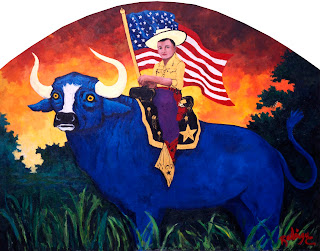Since childhood, George Rodrigue has loved the movies. It’s the reason, along with Saints and LSU football, that his studio doubles as a theatre, and why most nights he paints to the backdrop of Turner Classic Movies. He returns to his favorites, The Searchers and Lonesome Dove, repeatedly. And he spent his teenage years painting his renditions of the Creature from the Black Lagoon. This fall, George Rodrigue serves as the Featured Artist of the Carmel Art & Film Festival.
In 1974 Rodrigue experienced, for the first time up close, the movies, when he remained for a week on the set of The Drowning Pool, filmed partly at Oaklawn Plantation in Franklin, Louisiana. The set borrowed several Rodrigue Cajun paintings for the plantation house, but they shied away from the expensive insurance. Instead, they asked the artist to babysit the artwork during filming.
“I spent that week with Paul Newman, the cast, and my good friend Dr. Voorhies, Director of Charity Hospital in Lafayette, who was hired by the film people to be the crew’s physician. Nearly everyone on the set got sick because of the Louisiana farm country viruses and allergies.
“Despite the (relatively minor) health concerns, we had a fun time. All Paul Newman did was drink beer and, according to Dr. Voorhies, put drops in his eyes to keep them blue. I remember Newman drinking beer at breakfast.
“Ten years later, The Big Easy stocked their on-set and on-film refrigerator with my Jolie Blonde Beer. But I didn’t get to babysit that one!”
-click photos throughout to enlarge-
George Rodrigue painted Bush Films in 1983. The painting became a poster advertising an LPB documentary on the artist by Charles Bush of Louisiana Film Workshops. The movie coincided with the unveiling of Rodrigue’s 20-ft bronze statue, Legacy, depicting Longfellow, Evangeline and Gabriel. Regrettably, the movie is unavailable for on-line viewing.
A few years later, Rodrigue painted actress Dolores del Rio as Evangeline in a tribute to the 1929 silent movie filmed in Louisiana. The painting is part of his Saga of the Acadians, a series of fifteen paintings chronicling the Cajun journey from France to Canada, and from Nova Scotia to Louisiana.
In 1992, producer and director David DuBos filmed Rodrigue: A Man and His Dog with Whoopi Goldberg for Louisiana Public Broadcasting. Although the storyline has little connection to George’s recent paintings, at the time it followed his imagery, tracing his dog Tiffany as she searched for his studio in the afterlife.
The movie includes Rodrigue’s Cajun and Blue Dog paintings, as well as early footage from his studio and home in Lafayette, Louisiana.
(pictured, Me, Myself and I, 1992 by George Rodrigue)
“As the voice of the Blue Dog,” recalls Rodrigue, “Whoopi was very serious and professional, insisting on many takes to get it just right.”
The 8-minute clip below features Whoopi Goldberg as the black-and-white Tiffany, the Blue Dog, and the Red Dog. Be sure and watch to the end for some fun interviews with Chef Paul Prudhomme and others, along with Cajun music by Hadley Castille and the Sharecropper's Band.
In the late 1990s, the movies called again. This time it was Tri-Star pictures and the big screen, interested in a feature film based on the Blue Dog. George and I met with the movie folks in Los Angeles, considered the idea, and ultimately declined, as he weighed widespread fame against the importance of his copyrights and control of his art. Unlike his project for Xerox a few years later, this was too big a risk.
Passing on this project was tough for George, not only because he loves the movies, but also because he wrote a script. Within his movie, the Blue Dog exists only on the artist's canvas, as a spiritual conduit for an aging painter. He’s expanded and shaped this story for years, resulting in a fanciful tale of animals and art.
Today, the script remains fresh in his mind, as he occasionally reworks it, waking me in the middle of the night just last week to recount his latest version.
At his easel, his newest series, Hollywood Stars, features legends of the silver screen in large-scale artworks on metal.
At his easel, his newest series, Hollywood Stars, features legends of the silver screen in large-scale artworks on metal.
(pictured: New Orleans attorney, Laura Ashley, volunteers often with students and events at the George Rodrigue Foundation of the Arts. Rodrigue’s Some Like It Hot, along with similar works featuring Doris Day, Clint Eastwood, and Humphrey Bogart, is on view at his galleries in Carmel and New Orleans; details here-)
Also today, we celebrate the movies with the Carmel Art & Film Festival, an exciting event for Rodrigue, who is honored to serve as this year’s Featured Artist. The weekend deepens George’s connection to his second favorite state, a love born during the 1960s and his years at the Art Center College of Design in Los Angeles.
Hope to see you at the movies, October 9-13, 2013.
Wendy
-pictured above, George Rodrigue on the California coast, 1965-
-for details on the Carmel Art & Film Festival, including related Rodrigue events, visit carmelartandfilm.com -
-in addition to film, Blue Dog artwork appears occasionally on Reality TV, including a fun clip from Cajun Pawn Stars; story here-
-for more art and discussion, please join me on facebook-





































































































